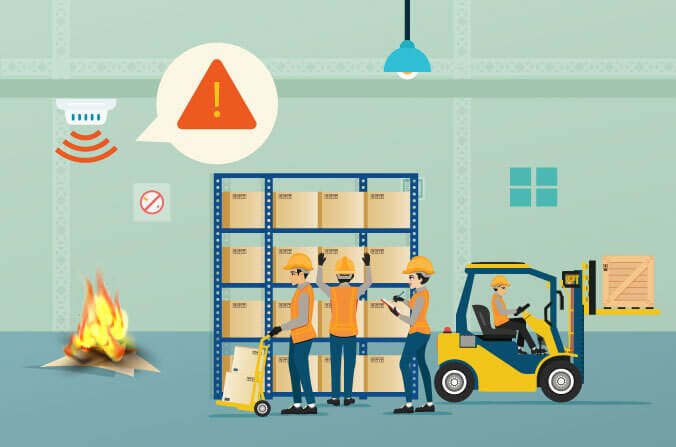Keep your warehouse safe with IGZY’s fire safety solution

Table of Contents
Fire hazards pose a threat to all types of businesses and can cause severe harm to both property and life. Fires don’t just cause damage but also cause business interruption, discontinuing operations for extended periods. This further adds to losses. Globally, the most substantial financial losses for businesses stem from fires and explosions. Therefore, it is absolutely necessary to prepare for such incidents beforehand, taking every precaution possible. With advancement in technology, fire safety solutions have expanded the scope of reducing damage or even extinguishing danger before it arises.
IGZY’s smart surveillance system provides a comprehensive set of solutions which improve monitoring capabilities and prevent a fire from causing damage. The fire safety solution is backed by intelligent sensors that can proactively detect anomalies, and the real-time alerts sent to escalations ensure that the situation is handled before any major damage can happen.
Fire Hazards in Warehouses
One industry which is highly susceptible to fire hazards is warehousing. There are a lot of things that can cause a fire in a warehouse. A detailed description of the most common causes of warehouse fires is given below.
1. Electrical Malfunctions
Warehouse fires most commonly arise from issues with lighting and electricity systems. Warehouses have large infrastructures to support storage of inventories. To support this, they also have big and complicated electricity and lighting systems. Electrical malfunctions, a small short circuit, a worn-out wire, blown fuse or simply unsupervised machinery, anywhere in the entire warehouse can cause a fire which can spread throughout the premises leading to loss of property and life.
Sometimes, something as small as a single short circuit can lead to a fire outbreak, causing loss of life and destruction of property.
2. Arson and Intentional fires
Arson or intentional fires are also a leading cause for fires in warehouses. It can either be a disgruntled employee who sets the fire or the owner of the warehouse who sets the fire for insurance purposes.
3. Overheating of machinery
Another major cause of warehouse fire is overheating of equipment and machinery due to unregulated temperature in the warehouse. A sudden increase in room temperatures can cause devices like air conditioners and refrigerators to fail, which can lead to fires.
4. Flammable commodities
Damage to flammable and combustible materials like chemicals and gases that a warehouse holds as inventory also pose a major threat of fire. These goods have to be stored under supervised conditions (like areas maintaining a particular level of temperature) and must be stored away from heating sources (including bulbs and other machinery).
5. Employee Negligence and Misconduct
Employee negligence is also a major threat to warehouses. Smoking cigarettes and misusing machines by negligent employees can lead to fires. A recent fire at a warehouse storing chemicals led to the unfortunate death of 12 people.
Managing fire hazards with IGZY’s Warehouse Management solution
A variety of warehouse surveillance solutions can be used to safeguard the warehouses from fires. IGZY’s fire safety solution is an integration of all the sensors and devices mentioned below.
1. Smoke Sensors
Smart smoke sensors can detect smoke throughout the premises and send real-time notifications to the relevant officials who can validate the situation and take further action. The location of the detector can give an accurate idea about the region requiring assistance, and the nearby stationed camera can provide insights into the intensity of the situation.
2. Energy meters
The energy meters continuously monitor the energy usage patterns across all the sites, keeping a check on the energy consumed on a daily, weekly and monthly basis. This can help control high fluctuations that may lead to short circuits of sensitive equipment and probable fires. Smart sensors can measure the amount of heat generated by electric current running through a circuit, thereby notifying authorized users about the areas causing probable outages.
3. Air quality sensors
The release of poisonous gases beyond the acceptable threshold can be identified and real time alerts be triggered for the timely regulation over whichever activity is causing its release. The air quality index reports enlighten employers about the level of hazardous gases present in the air.
4. Temperature monitoring & Control
Unprecedented rise in room temperature can lead to overheating of the machinery and devices being used as well as lead to combustion of reactive commodities and oil spills around ignition sources. Control over room temperature becomes necessary in such scenarios.
5. Real-time notifications
The biggest advantage of having smart sensors is that they can send real time notifications to a common command center. Here. The alerts can be verified faster and the matter can be escalated to proper authorities quickly.
Many fire hazards occur during night time when there is little staff to monitor and respond on time. These notifications are therefore very important as they work in tandem with all the smart sensors to provide 24*7 monitoring support.
6. Equipment maintenance (with LHT sensors)
LHT sensors detect the levels of light, humidity and temperature of a unit and compare it to the predefined threshold. Marginal deviations from these threshold levels suggest that a machine is not working in its optimum state and might need to be fixed. These sensors make sure that the relevant authorities are notified. This proactively reduces the chances of any damage to machines and also reduces possibility of them failing and causing fires.
These systems can also make sure that the basic SOPs are adhered to by the employees. They can monitor how the products are being handled. The system can also monitor whether the flammable commodities like gases and chemicals are stored properly or not. They can make sure these commodities are not near a fire source or somewhere they could catch fire. The system can also monitor machines and their working patterns. It can detect unusual patterns and downtime for machines. Various other SOP guidelines can be monitored as per a client’s needs.
7. Fire alarms
Fire alarms are the most basic and essential tool during a fire. These alarms are used to alert people as soon as smoke, fire or poisonous gases are detected in the premises. These alarms can be triggered directly when a smoke sensor or temperature sensor is triggered or they can also be activated manually through manual pull stations. They are extremely necessary to warn employees of a fire and facilitate a quick evacuation.
Conclusion
It can be seen that protecting against a fire is extremely important as the damage here is not only limited to property and goods but also to life. IGZY, under its warehouse security solutions, gives you the best tools to fight proactively against a fire hazard. IGZY’s fire safety solution is backed by round the clock monitoring facilities, securing your premises from all possible fire hazards so that you can have peace of mind.
To know more about our fire safety solution and its easy integration across scales, get in contact today.





